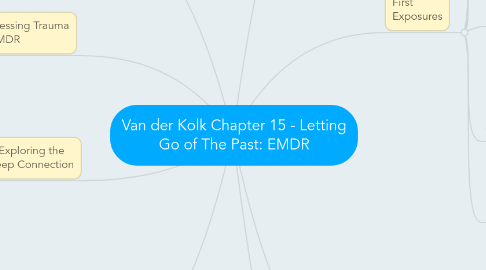
1. 1) Learning about EMDR
1.1. Maggie learns EMDR
1.2. Van der Kolk is skeptical
1.3. Maggie revisits her trauma from the view of her adult self
1.4. Maggie resolves her trauma
2. 2) EMDR: First Exposures
2.1. Francine Shapiro develops EMDR by chance
2.2. EMDR has been standardized
2.3. Van der Kolk experiences EMDR
2.3.1. releases anger & stress
2.3.2. different than talk therapy
2.4. Van der Kolk does EMDR
2.4.1. partner will not disclose details
2.4.2. partner resolves his abuse with EMDR
2.5. Van der Kolk is troubled by not knowing the trauma story
2.6. EMDR Trainer confronts van der Kolk
2.6.1. did he become a therapist to resolve his own issues
2.6.2. does he find meaning in hearing peoples stories
2.6.3. Need to know the difference between needing to hear trauma stories and the patient's internal process of healing
2.7. Three issues:
2.7.1. EMDR loosens up access to past memory and images that put trauma into a larger context/perspective
2.7.2. People can heal from trauma without talking about it - they can observe their experience in a new way
2.7.3. EMDR can help even when there is a poor therapeutic relationship
2.8. EMDR can be used even with other cultures and languages
3. 3) Studying EMDR
3.1. EMDR & Brain Scans
3.1.1. 3 sessions - decrease in PTSD score
3.1.2. increase in prefrontal lobe activity
3.1.3. increased activity in anterior cingulate & basal ganglia
3.2. Randomized Controlled Trial of EMDR vs Prozac vs Placebo (Van der Kolk et al., 2007)
3.3. Key Findings
3.3.1. EMDR is more effective than medication
3.3.2. Medication improvement only lasts while people take it
3.3.3. Adults with a history of childhood trauma respond more poorly than those with adult trauma
3.3.3.1. Adult trauma 73% cure rate
3.3.3.2. Childhood trauma 25% cure rate
4. 4) Is EMDR a Form of Exposure Therapy?
4.1. PTSD memories
4.1.1. memory is stuck, undigested & raw
4.2. With Exposure Therapy
4.2.1. Sharp increase in heart rate, BP & Stress
4.2.2. Slowly become less reactive
4.2.3. Memories do not integrate into their lives
4.3. With EMDR
4.3.1. The trauma is a coherent event in the past
4.3.2. Restores a sense of agency, engagement & committment
4.4. EMDR is different than Exposure Therapy
5. 5) Processing Trauma with EMDR
5.1. Case example with Kathy
5.1.1. Extensive childhood trauma
5.1.2. Recovered completely in 8 sessions
5.1.3. She was able to integrate memories of her trauma
6. 6) Exploring the Sleep Connection
6.1. EMDR eye movements are connected to REM sleep eye movements
6.2. Deep sleep & REM sleep are related to memory processing
6.3. REM sleep is decreased in PTSD
6.4. REM sleep is related to non-linear associations
6.5. EMDR may be related to memory processing in dreams through similarity of eye movements
7. 7) Association and Integration
7.1. EMDR starts with the trauma memory but focuses on stimulating and opening the associative process
7.2. Prozac can blunt the images and sensations of terror BUT they are NOT integrated into memory
7.3. The mechanism of change is not known for either EMDR or Prozac
7.4. Our obligation as clinicians is to do what we can to help patients (service users) get better
7.5. Clinical practice involves experimentation - some fail and others change how therapy is practiced:
7.5.1. EMDR
7.5.2. Dialectical Behaviour Therapy (DBT)
7.5.3. Internal Family Systems Therapy (IFS)
